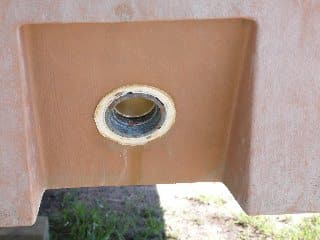
underwaterlighthole_001_8234.jpg
Today’s installment is a sad one. Its the story of a brand new boat, the buyer’s dreamboat if you will, that sank in its slip about 1 month after he took delivery. The photo below shows the hole in the boat that caused the sinking.

Hole where under water light fixture was fitted
The white ring you can see around the perimeter of the hole is where the flange for the fixture was fitted. The white stuff is the 3-M 5200 used to seal the fitting. So the question is, where’s the flange and the light?
This my friends is a sad tale of electrolytic corrosion, or to most people, stray current corrosion. This is of the DC variety and I can tell you that what you see here did not take to much time to occur. Although we can’t be sure of the exact amount of usage on the underwater lights, what I can tell you for sure is that whenever they had power to them there was also a low level short circuit from the DC power feed to the light that was touching the bronze housing for the light. Why? Simple, the installer did not use an insulated terminal. But further the inside of the housing was not provided with any insulation by the light manufacturer, it was just nice raw bronze, totally uninsulated.
I can also tell you that the light was of the halogen variety and was therefore rated at a fairly high DC current, a little over 8 amps to be exact. So, what was going on here is that whenever the light was turned on, a portion of that electric current was exiting the fixture through the flange of the light, forcing the flange to act as an anode. The bottom line? The flange face simply fizzed away un-noticed and ultimately popped off. The light fixture then fell backwards inside the boat and the rest is history. This fellow’s $400 K dreamboat sank in its berth.
So what’s the lesson here? Make sure that there is no way possible for the power lead or terminals supplying power to any underwater light fixtures can come in contact with one another. That point of contact is a guaranteed recipe for disaster!







